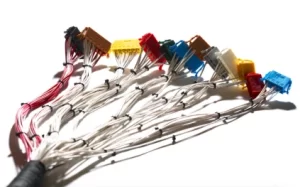A harness would also be called a cable harness or wiring assembly. It offers an orderly method so that it is easy to keep many wires and cables safely inside a system. In other words, it is a complicated assembly of electrical cables or wires, which transmit signals or electrical power inside devices. These harnesses, which are fastened with straps, cable ties, conduit, sleeves, or a combination thereof, can prevent adverse conditions from damaging the wires and reduce the possibility of electrical fires or shorts. This blog will not only outline various elements that impact the wire harness prices but also go into details regarding harness wire pricing. By providing a detailed glance at these crucial elements, we intend to disclose their complicated structure of pricing and trends within the industry. Furthermore, this discussion will explain how wire harness prices are shaped by a range of factors, from raw material costs to advances in technology and everything between, serving as an exploratory road map for companies involved in this market.
1. Cable Material Costs:
Copper and Aluminum: Copper is one of the major cable materials used in cable harnesses because of excellent electric conductivity. The fluctuating cost of copper depends very strongly on year-to-year market demand versus mining outputs, which greatly affects the cost of wire harness production. For instance, late in 2023, copper prices had hitched at $8,000 per ton, being significantly raised from the prior years driven by increasing dema
nd for electronics and electric cars. Aluminum, being used as the light and cheaper alternative, follows a similar market trend but generally stays cheaper.
Plastic and Rubber Insulation: The plastics used for insulation like PVC or polyethylene are basically derived from petroleum; hence the pricing depends on the price of oil. For example, a sharp rise in oil prices can raise the rate of plastic materials by 10-15%; this directly impacts and results in an increase in the total cost of manufacturing wire harness.
2. Labor and manufacturing processes:
Automation vs. Manual: This is quite varied because the automation level for wire harnesses determines the cost of labor. Companies in more developed countries will have higher labor costs and would want to invest in sophisticated machinery that automates wire cutting, wire stripping, and wire crimping, which saves workforce resources but increases initial capital costs. A fully automatic wire-processing line can cost upwards of US$100,000 and cut down on labor costs by 30-50% in the long term.
Geographical Variations: The cost of labor sometimes follows very disconcerting variations depending on the site of manufacture. In regions such as Germany or the USA, the labor costs might be as high as $30-40 per hour, while in regions as close as Southeast Asia, the same may be below US$ 10 per hour. This disparity in labor cost could make a lot of difference during final costing and often proves to be one of the main determinants for a global sourcing decision.

3. Design and Customization:
For wire harnesses that are custom-designed and made according to the limited requirements of the customer, a great deal of deliberate design is involved, along with a testing process that increases the overhead associated with each unit, and therefore the wire harness prices.
4. Technological Integration:
With more and more complex devices working off electrical power, the wire harnesses themselves become that more complex. Additional features of a wire harness include integrated circuitry or even built-in signal processing facilities, amongst others.
5. Economies of Scale:
Manufacturers who produce the wire harness in high quantities spread large production costs around many units, which tend to lower the cost per harness to the respective customers.
6. Regulatory Compliance:
In many industries, including automotive and aerospace, wire harnesses are subject to very stringent safety and quality standards. Complying with these standards can add to the component materials and involve quality assurance activities, thereby increasing the cost and the wire harness price.
Harness wire is the individual wires within a harness are called. These are often single-conductor wires made to specific specifications in flexibility, strength, and conductivity. They are selected based on their application and service that a wire harness will see, taking into account extreme temperature, mechanical abrasion, chemical exposure, and other special environmental conditions a harness will encounter.
The main difference between harness wire price and cable harness price consists in the fact that, on one hand, a wire harness means assembly of components, while, on the other hand, hook wire is a part of this assembly. Wire harness is considered as a system against its holistic design for effectiveness and organization in complex systems of electrical nature. Harness wire gives consideration only to its individual wire specifications and unit characteristics within the system.
The wire harness market is impacted directly by several global trends affecting wire harness prices:
1. Shift to Electric Vehicles: The shift of the automotive sector into EVs has driven the demand for wire harnesses wonderfully that are capable of managing high voltages and currents, thereby leading to new investments in specialized harness production facilities.
2. Renewable Energy Projects: Solar and wind energy projects are increasing; this, in turn, increases the usage of wire harnesses in these installations. For example, harnesses utilized in solar panels that need to withstand UV light and weather conditions usually call for specific materials and designs, which in turn affect their cost structure.
3. Trade Policies and Tariffs: Changes in the global policy stance on trade in recent years have shifted supply chains and altered pricing. Tariffs, such as those the United States has assessed against Chinese goods-including electronic components-may result in manufacturers shifting production or sourcing from other countries to avoid such tariffs. This is one of the factors that will continue to impact wire harness cost and supplies.
4. Technology Developments: In the production of wire harnesses, high-level technologies like automation and artificial intelligence are going to lead to a decrease in labor costs and more accuracy. However, initial installations require heavy capital investments that could increase the cost of production temporarily before yielding long-term savings.
Many components make up the supply chain for wire harnesses, and each can have its variable impact on the final cost of a product or its availability.
1. Availability of Raw Materials: The cost of copper, which is a big raw material factor for wire harnesses, is highly volatile. For example, any political unrest in C
hile can result in a lot of spikes related to its price.
2. Logistic Challenges: Inability of wire harnessing manufacturing to meet demand equates to the COVID-19 pandemic, which has demonstrated clearly that problems in international logistics contribute to these eventualities as shipping delays and increased freight cost, consequently leading to a shortage with increased wire harness prices in the commodity. Thus, manufacturers had to find means of surviving these challenges by adjusting their inventory level and sometimes passing the increased costs to consumers.
3. Diversification by Supplier: Companies that had diversified their pool of suppliers before the pandemic were capable of controlling the disruptions on their industry better. For instance, a manufacturer sourcing insulation materials from different countries can switch their source compared to firms reliant on a single source.
4. Fluctuating Demand: Major projects or unexpected shifts in consumer demand may trigger the demand for wire harnesses. A good example is the temporary demand for wire harnesses in telecommunications equipment that has been witnessed with the deployment of 5G networks.
Good cost management strategies to reduce wire harness price would involve some of the following approaches:
1. Engaging in strategic sourcing: This involves the negotiation of long-term contracts with suppliers with the aim material prices and a reliable supply chain.
2. Just-in-Time Manufacturing: The decrease in the cost of inventory by receiving goods only when they are utilised in actual production processes will improve cash flow and reduce storage costs, making the production cycle efficient enough to respond to market fluctuations.
It is a dynamic industry influenced by many factors that impact pricing. While each element is significant to businesses for cost control and lean supply operations, it is hard to keep a close watch on them. With information, a company is better placed to make its way through the confusing labyrinth of the wire harness market continuously in touch with material costs, technological trends, and market dynamics.
We offer a whole gamut of wire harness products tailored to meet the needs of every aspect. We therefore invite you to take a tour and find the most befitting solutions that not only cater to your specific needs but also concern the constraints of the budget, so as to keep a leading edge in today’s highly competitive market. For more updated products and wire harness prices, please check Our website.
Related Reading
How to Choose the Right Electronic Wire Cables
Types and Applications of Copper Wire: A Step-by-Step Guide
Tinned Copper Wire VS Bare Copper Wire: Definition, Benefits, Applications, and How to Choose
Different Types of Electric Wires: Residential Application, Uses and How to Select

15 years of experience in manufacturing wire and cable industry, especially good at content creation in LED wiring harness and energy wiring harness industry
As a renowned cable harness solution provider giant VOCSON can ensure that your project is leading the industry, Choose us to provide wire harness products, and OEM or ODM services for you.